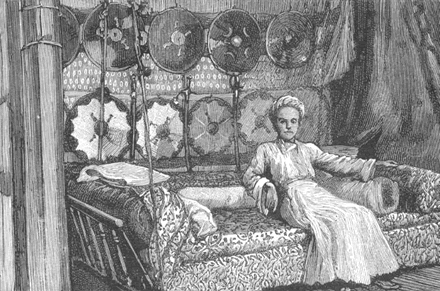File:Part of the reception-room of the High Priest, showing the bed and shields used by the fencers, 1885 - The Graphic 1886.gif
Part_of_the_reception-room_of_the_High_Priest,_showing_the_bed_and_shields_used_by_the_fencers,_1885_-_The_Graphic_1886.gif (440 × 291 pixels, file size: 69 KB, MIME type: image/gif, 0.2 s)
Captions
Captions
Summary
[edit]| Part of the reception-room of the High Priest, showing the bed and shields used by the fencers | |
|---|---|
| Artist |
Unknown artistUnknown artist, The Graphic Staff, after photographs taken by C. H. Rosset |
| Author |
The Graphic, text by C. H. Rosset |
| Title |
Part of the reception-room of the High Priest, showing the bed and shields used by the fencers |
| Description |
The Maldive Islands. Illustration for The Graphic, 16 October 1886. Full caption: Part of the reception-room of the High Priest, showing the bed and shields used by the fencers. These shields are the only ones allowed on the islands. and are always kept in this apartment. See page 415 See explanatory text on page 416 Hassan Deedee, title Fanu Dairi Kilage-fanu: Hassan Deedee is a cousin of E. A. Abrahim Deedee (the Prime Minister), and has the command of the army; his principal duty being to superintend the fencing and dancing games which are held periodically by order of the Sultan. On special occasions organised spoils are held, which are generally witnessed by the Sultan and his wives. At these sports the young men generally engage, two at a time, in a kind of fencing exercise with sticks; which is, however, entirely without interest. The two principal games or dances are the Malikutara and the Todu. The first came originally from Minicoy (hence its name), and is performed by about twenty tom-tom beaters, who go through a series of slow movements, accompanying their gestures by a regular thumping of their instruments The second game is of pure Maldive origin; it originated in Ari Atol, and is performed by about six couples of fencers, armed with wands some six feet long, to the ends, which are fixed metal boxes filled with cowries, resembling children's rattles in Europe. With these they go through a series of movements, timed to the regular beat of tom-tom, and by striking the wands against on and other, make a continuous rattling noise. C.W. Rosset visited Maldives in 1885 during Sultan Ibrahim Nooraddeen's reign. The Maldive Islands. Illustration for The Graphic, 16 October 1886. Illustration which appeared in an article in en:The Graphic depicts veranda swing (Fendaamathi Undholi) of royal palace, by the German C.W. Rosett (Carl Wilhelm Rosset (1851-1923). He visited Maldives in 25th October, 1885 and stayed in en:Malé. His purpose was to exhibit his findings at the Colonial and Indian exhibition. Source for this last paragraph, gives reference to sing, a typo should be swing. |
| Date |
16 October 1886 date QS:P571,+1886-10-16T00:00:00Z/11 |
| Source/Photographer | http://www.maldivesroyalfamily.com/rosset.shtml |
Licensing
[edit]|
This is a faithful photographic reproduction of a two-dimensional, public domain work of art. The work of art itself is in the public domain for the following reason:
The official position taken by the Wikimedia Foundation is that "faithful reproductions of two-dimensional public domain works of art are public domain".
This photographic reproduction is therefore also considered to be in the public domain in the United States. In other jurisdictions, re-use of this content may be restricted; see Reuse of PD-Art photographs for details. | |||||
File history
Click on a date/time to view the file as it appeared at that time.
| Date/Time | Thumbnail | Dimensions | User | Comment | |
|---|---|---|---|---|---|
| current | 21:04, 22 December 2008 |  | 440 × 291 (69 KB) | FaranjiPyrard (talk | contribs) | {{Information |Description=Illustration which appears in an article in The Graphic depicts veranda sing (Fendaamathi Undholi) of royal palace, by the Englishmen CW Rosett. He visited Maldives in 25th October, 1885 and stayed in Malé, his purpose |
You cannot overwrite this file.
File usage on Commons
The following 4 pages use this file:
File usage on other wikis
The following other wikis use this file:
- Usage on bn.wikipedia.org
- Usage on en.wikipedia.org
- Usage on hi.wikipedia.org
- Usage on kn.wikipedia.org
